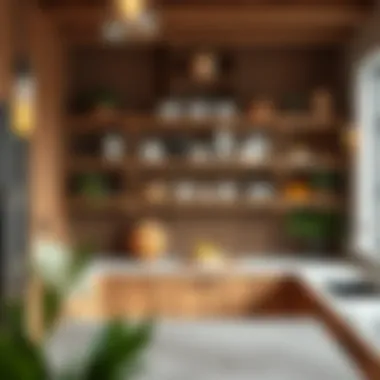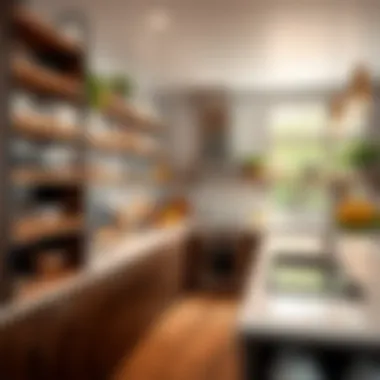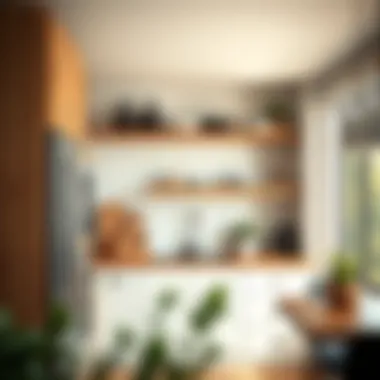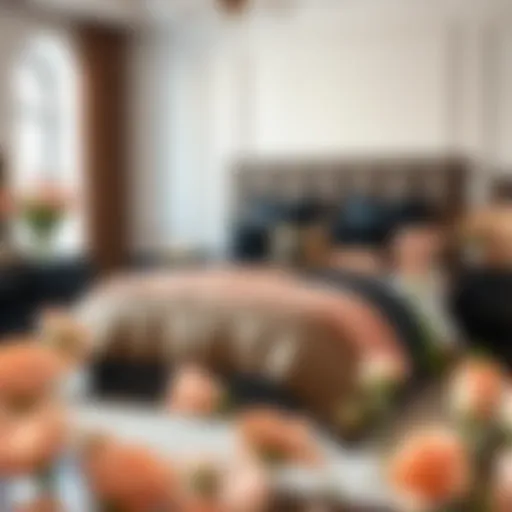Wooden Shelves: Transforming Kitchen Design


Intro
When it comes to kitchen design, the balance of style, functionality, and sustainability often begins with the choice of furnishings. Wooden shelves are increasingly finding their place in modern kitchens, not just for their practical benefits but also for their aesthetic appeal. They invite warmth into the often hard surfaces typical of a kitchen, and their versatility allows them to fit into various designs, from minimalist to rustic.
The following sections aim to dissect the multifarious roles wooden shelves play in kitchen environments, examining everything from current design trends to care tips, thereby providing insights into how to effectively integrate these charming pieces into one's culinary space. Whether you are a homeowner, a designer, a keen DIY enthusiast, or a retailer, this guide is set to furnish you with the knowledge to enrich your kitchen’s character and appeal.
Prelude to Wooden Shelves in the Kitchen
As kitchens evolve into multi-functional spaces where culinary creativity meets social gathering, the inclusion of wooden shelves emerges as a pivotal design choice. Wooden shelving not only enhances the aesthetic appeal of a kitchen but also provides practicality and efficient storage solutions. This exploration aims to unveil the significant role these shelves play in kitchen environments, focusing on their impact on organization, ambiance, and sustainability.
The Growing Popularity of Wooden Shelving
In recent years, wooden shelves have gained traction in kitchen design, driven by a blend of nostalgia and modernity. Homeowners and designers are embracing the warmth of wood, shifting away from cold, sterile materials. This resurgence stems from a desire for spaces that feel cozy and inviting. Whether it’s reclaimed barn wood or sleek maple, each type offers its unique flair. Moreover, the versatility in finishes allows individuals to tailor their kitchen's look—from rustic farmhouse to polished contemporary.
The shift towards open shelving reflects a broader trend in interior design favoring transparency and accessibility. People are eager to display their neatly arranged dishes or hand-picked decor items, creating kitchens that communicate personal style. In many cases, wooden shelves take center stage in open-concept designs, effortlessly bridging the gap between the kitchen and living areas. With accents like brass brackets or wrought iron supports, these shelves become more than functional; they transform into artistic elements of the home.
Functional Versatility of Kitchen Shelves
When considering the functionality of wooden shelves, their adaptability stands out. These shelves serve multiple purposes, making them a smart investment for any kitchen. For instance, they can efficiently hold spices, cookbooks, or decorative items, thus maintaining a clutter-free counter. This not only declutters spaces but also enhances the cooking experience, making ingredients and tools easily accessible.
- Storage Solutions: The ability to utilize vertical space is a game-changer. This is especially valuable in smaller kitchens where every inch counts.
- Customization: Homeowners have the option to design shelves to their preferences, choosing sizes and configurations that suit specific needs. Whether it’s a broad span for large pots or a narrower rack for herbs, customization can cater to any requirement.
- Creative Displays: Aside from practical storage, wooden shelves allow for creativity. They can host unique displays—like a collection of vintage kitchenware or potted herbs—inviting personality into the space.
Ultimately, the functional versatility of wooden shelves in the kitchen translates to a spot that doesn't merely serve utility; it invites inspiration and organization—qualities that resonate deeply with modern sensibilities.
Types of Wood for Kitchen Shelves
When it comes to crafting wooden shelves for kitchen environments, the selection of wood plays a pivotal role. The type of wood affects not only the aesthetic appeal but also the durability, flexibility, and even the maintenance of the shelves. Understanding the distinctions between different woods can help homeowners and designers make informed choices that harmonize style and function within the kitchen.
Hardwoods vs. Softwoods
One key consideration in selecting wood is the distinction between hardwoods and softwoods. Hardwoods, which come from deciduous trees, typically exhibit a higher density and durability. They are well-suited for kitchen cabinetry and shelves that endure regular use. On the flip side, softwoods, derived from coniferous trees, often present a lighter weight and may be more affordable, but they tend to be less sturdy. When deciding between hardwoods and softwoods for kitchen shelving, it’s essential to weigh factors like cost, usage frequency, and aesthetic preferences.
Common Wood Species Used
Oak
Oak is renowned for its resilience and timeless appeal, making it an optimal choice for kitchen shelves. One key characteristic of oak is its beautiful grain patterns, ranging from light to dark hues. This visual aspect contributes greatly to any kitchen, adding a touch of elegance. Moreover, oak's durability ensures that it can stand the test of time against wear and tear. However, oak can be quite heavy, which may complicate installation. Additionally, it has a tendency to absorb moisture, so caution is necessary in particularly humid environments.
Maple
Maple is another solid contender that has earned a reputation for its clean and smooth finish. It’s less expensive than some hardwoods and still brings strength to the table. Maple's lighter color provides a fresher look, which can brighten up a space significantly. However, it might be prone to scratches and dents over time, particularly in busy family kitchens. Its affordability makes it a popular choice for those looking to balance cost and quality.
Walnut
Walnut is celebrated for its striking deep tones and luxury feel. The rich color of walnut can elevate the look of any kitchen into a sophisticated realm. This wood species is strong, resistant to warping, and possesses a natural resistance to moisture, making it an ideal material for kitchen shelving. However, its higher cost might be a decisive factor for budget-conscious homeowners. The unique feature of walnut is the stunning grain patterns, which can catch the eye and become a focal point in kitchen design.
Birch
Birch is quite versatile and is known for its fine grain and ability to adopt stains effectively, allowing for various finishing options. Its light color can help create an airy feeling within the kitchen. While birch is generally strong, it’s not as robust as oak or maple when it comes to heavy items. Therefore, it’s best suited for displaying lighter kitchenware or decorative items. In summary, its adaptability in aesthetic treatments allows for creativity in kitchen design.
Pine
Pine is widely accessible and offers a warm, rustic charm to kitchens. Its lightweight nature makes it easy to install, a huge plus for DIYers. However, it does tend to be softer and can dent more easily, which may necessitate more frequent replacements or repairs. On the other side, its affordability attracts many, making it a favored choice for budget-friendly projects.
Sustainability Considerations
Selecting the right wood type is not just about durability or appearance; it also involves understanding sustainability. Today, more homeowners and designers are leaning towards sustainably sourced woods, which are harvested in a manner that preserves forests and ecosystems. Supporting brands that offer certified sustainably sourced materials can reflect an individual's commitment to environmental stewardship. This approach not only benefits the planet but often also enhances the marketability of homes, as sustainability becomes a key focus in design trends.
"Choosing the right wood for kitchen shelves is an investment in both form and function, reflecting personal style and environmental values alike."
When selecting wooden shelves for your kitchen, it's clear that each wood species offers its unique advantages and potential drawbacks. Consider both aesthetic choices and practical functions when making this important decision.
Design Styles for Wooden Kitchen Shelves
When it comes to wooden shelves in kitchen design, selecting the correct style can make or break the overall ambiance. It's not just about storage; it’s also about how these elements blend with the kitchen's aesthetic. The design styles act as a canvas, showcasing the personality of the space. Imagine walking into a kitchen where every detail echoes a theme, from the shelves to the cabinetry.
This section will explore various design styles like rustic, modern, and industrial, focusing on how they contribute to the kitchen environment. By understanding these styles, homeowners and designers can harmoniously integrate wooden shelving, maximizing both function and form.
Rustic and Farmhouse Styles
Rustic and farmhouse styles herald back to simpler times. They invoke warmth and comfort, often showcasing elements that appear naturally weathered or distressed. These styles favor rough-hewn wood, exuding an organic feel. In this context, wooden shelves can be broad and robust, providing ample space for dishes and cookbooks while simultaneously acting as decor.
- Natural Finish: A natural wood finish enhances the rustic aesthetic. Beams and boards may come from reclaimed sources, lending a backstory to each plank.
- Decorative Elements: Items like mason jars, vintage cookware, and woven baskets can enhance the rustic look. A few essential oils or herbs in terracotta pots can breathe life into the shelves.
- Practicality Meets Style: These shelves can double as a place for everyday essentials while allowing decoration to shine—functionality is well married to aesthetics.
The rustic appeal of wooden shelves also nurtures an inviting environment, making it a favorite choice for homes aiming for a cozy feel.
Modern and Minimalist Trends
Switching gears to a modern and minimalist design, wooden shelves here tend to emphasize simplicity and clean lines. The focus is on creating space that feels open and uncluttered. These shelves often utilize lighter woods or more refined finishes, aligning with the minimalist philosophy that less is more.


- Strategic Placement: In modern kitchens, shelves might be placed strategically to ensure easy access while maintaining an airy feel. They can float on walls without visible support, creating a sleek appearance.
- Color Schemes: Monochromatic or neutral color palettes are prevalent, often paired with stainless steel appliances. Here, the wood serves as a soft contrast to cooler materials.
- Functional Decor: Items on display are chosen not just for function but also for design. Think of essential oils in chic containers or simple dishware that harmonize with the overall color scheme.
The modern and minimalist trend allows for a serene space, where each piece of wood contributes to a greater sense of harmony in the kitchen.
Industrial Aesthetics
Industrial aesthetics embrace a raw and edgy design, often featuring exposed structures and unrefined surfaces. In this style, wooden shelves take on a different character. They often combine with metal elements, like brackets or frames, adding to the industrial vibe.
- Mixed Material Use: This design allows for unexpected combinations. Solid oak might pair seamlessly with galvanized metal for a dynamic visual effect, creating strong contrasts that catch the eye.
- Utilitarian Approach: Items displayed on these shelves often have a robust quality. Tools and utensils may be left on show, reinforcing a sense of utility.
- Color Palette: Typically, the color palette involves darker or muted tones with hints of rusty or weathered finishes that blend well in urban environments.
In the industrial style, wooden shelves are far from ordinary—they become focal points that convey character and history, making the kitchen feel more alive.
By understanding various design styles, homeowners and designers can better choose wooden shelves that not only fit their personal tastes but also enhance the kitchen's overall function and charm.
In sum, each design style offers unique attributes and aesthetics that can cater to diverse preferences. Whether it is the comforting warmth of rustic shelves or the sleekness of modern designs, the choices made will define the culinary atmosphere.
Selective Placement and Configuration
The arrangement of wooden shelves in a kitchen is not just about aesthetics; it's a careful dance between functionality and design. Strategic placement can enhance both the usability of space and the overall look of the kitchen. Selecting the right configuration for wooden shelves can transform an ordinary kitchen into a highly efficient workspace while also showcasing personality through decorative choices. Here’s how to get it right.
Wall-Mounted vs. Freestanding Shelves
When deciding between wall-mounted and freestanding shelves, consider the unique advantages of each style. Wall-mounted shelves tend to save space, creating an airy feel. They’re ideal for smaller kitchens where real estate is at a premium.
- Space Efficiency: By climbing vertically, they free up floor space, allowing for easy movement.
- Design Flexibility: Wall-mounted options can be customized to any height or width, which makes them adaptable to varying kitchen layouts.
On the other hand, freestanding shelves often bring a certain charm to the kitchen. They can serve as a statement piece, or even a room divider in open-plan spaces. Here are some things to consider when choosing freestanding options:
- Mobility: These shelves can be moved around, providing flexibility in rearranging your kitchen layout.
- Storage Capacity: Freestanding designs often offer deeper shelves and more substantial storage options.
"Selecting the right shelf type hinges not only on style preference but also on functional needs. Think through how you use your kitchen daily."
Utilizing Corner Spaces
Corners in kitchens are often neglected, but with clever planning, they can be transformed into functional storage areas. Utilizing corner spaces by installing specially designed corner shelves maximizes every inch of space available. Here are some clever tips:
- Lazy Susans: These rotating trays are perfect for keeping spices or smaller kitchen gadgets easily accessible.
- Tall Corner Shelving Units: They draw the eye upward and can be used to store bulky items without crowding the area.
Think outside the box; for example, if you have a breakfast nook, corner shelves can host cookbooks and decorative plants, marrying style with practicality.
Open vs. Closed Shelving
The ongoing debate between open and closed shelving is reminiscent of choosing between jeans and tailored pants; each has its place, depending on the occasion. Open shelving promotes accessibility, making everyday items easy to reach. It’s perfect for showcasing your most attractive dishes or cookbooks.
- Accessibility: Open shelving allows for quick access to items, which is especially handy in busy kitchens.
- Aesthetic Appeal: It can be styled beautifully with a mix of functional and decorative items.
However, closed shelving offers a tidy appearance while protecting contents from dust and grease. Here, items can be cleverly concealed, allowing for a cleaner look.
- Clutter Control: It’s easier to keep a uniform look and hide less attractive items.
- Weather Resistance: Closed shelves can keep delicate items, such as glassware, safer from potential kitchen mishaps.
When deciding, think about the overall kitchen style and your lifestyle. If you’re someone who loves to cook often and needs easy access to ingredients, open shelving might be your choice. However, if there are kids around, closed designs might save you from a few spills.
Installing Wooden Shelves in the Kitchen
The installation of wooden shelves in the kitchen is a foundational aspect that significantly contributes to both the functionality and aesthetic appeal of the space. Incorporating wooden shelves is not merely about storage; it encapsulates a philosophy of design wherein style, utility, and organization coalesce into one harmonious framework. From classic farmhouse styles to sleek modern designs, wooden shelves serve as a versatile component, elevating the kitchen’s atmosphere and enabling better space management.
When considering this installation, several factors come to the surface. Firstly, there is a practicality angle. Well-placed shelves can eliminate clutter, provide easy access to kitchen essentials, and create an inviting display for decorative items. Furthermore, with the right choices, they can enhance the overall theme of the kitchen, making it not just a cooking area but a personal sanctuary.
Tools and Materials Required
The successful installation of wooden shelves hinges on having the right tools and materials before diving into the project. Here’s a checklist to get you started:
- Wooden Planks: Select quality wood, either from the hardwood or softwood category, depending on your preference.
- Brackets and Supports: Choose sturdy brackets that complement the design of your shelves.
- Drill: A power drill will make the task of securing your shelves much easier.
- Screws: Wood screws are essential for attaching brackets and supports.
- Level: Ensuring shelves are level prevents items from sliding off.
- Measuring Tape: Accurate measurements are critical for both spacing and fitting.
- Sandpaper: For smoothing edges of the wooden shelves post-cutting.
Preparing these tools and materials ahead of time helps streamline the installation process, making it a smooth operation.
Step-by-Step Installation Guide
Installing wooden shelves isn't as daunting as it appears. Here’s a simplified step-by-step guide to assist you throughout the process:
- Measure the Space: Start by determining where the shelves will be located. Take note of the height and width, considering the items you plan to place on the shelves.
- Mark bracket placement: Use the measuring tape and level to mark where the brackets will go on the wall. Make sure they align horizontally.
- Drill holes: After marking, drill holes into the wall for the wall anchors if you’re using them for support.
- Install brackets: Secure the brackets to the wall with appropriate screws. Make sure they are stable enough to hold the weight of your shelves and any items.
- Attach shelves: Finally, place the wooden shelves onto the brackets, ensuring everything is level and secure.


Completing these steps will result in well-installed wooden shelves that blend seamlessly into your kitchen design.
Safety Precautions
Safety should always be at the forefront when undertaking any DIY project. Here are some precautions to keep in mind before, during, and after the installation:
- Wear Protective Gear: Consider wearing safety glasses and gloves to avoid injuries from sawdust and sharp edges.
- Check for Electrical Wires: Use a wire detector to ensure there are no hidden electrical wires where you're drilling.
- Hold Steady: When lifting heavy shelves or working at heights, ensure you have support to avoid accidents.
- Stability Check: Before loading shelves with items, double-check to ensure they are firmly mounted and can handle the weight.
"A well-built shelf not only stores your valuables but also tells a story about your style and choices."
Taking these precautions into account mitigates potential risks, allowing for a smoother installation process that prioritizes safety and order.
Styling Wooden Shelves
Styling wooden shelves goes beyond mere functionality; it captures the essence of personality and aesthetic in kitchen spaces. Just as any piece of furniture adds a layer of life to a room, well-styled shelves can elevate the entire kitchen experience. Choosing the right items, arranging them thoughtfully, and incorporating natural elements turns a simple shelf into a statement that resonates with both the heart and eye. The strategic use of decorative items on these shelves allows homeowners and designers alike to express creativity while ensuring functionality remains intact.
Choosing Decorative Items
When it comes to selecting decorative items for wooden shelves, one has to tread the fine line between style and practicality. Using various shapes, sizes, and textures can create a dynamic visual appeal. Here are a few guidelines:
- Balance: Ensure that the items vary in height and volume. Shelves should never feel cluttered, so placing larger items like bowls or jars with smaller ones creates equilibrium.
- Theme: Consider a central theme. Rustic wooden items may pair beautifully with vintage ceramic pieces, while sleek glass can lend a more contemporary edge.
- Color Palette: Opt for colors that resonate with the overall kitchen design. Warm natural tones work well with earthy wood grains, while vibrant hues can offer a pop of color to neutral spaces.
A good idea is to incorporate personal elements too, such as family cookbooks or handmade pottery, which not only add charm but also bring warmth to the kitchen.
Arranging for Practicality and Aesthetics
Stacking items haphazardly on wooden shelves can leave a chaotic impression. Instead, a thoughtful arrangement can fulfill both practical needs and aesthetic desires. Here’s how:
- Frequency of Use: Items used often should be more accessible. Place everyday kitchen utensils or frequently used ingredients at eye level. Less common items can be placed higher up.
- Group Similar Items: For coherence, cluster similar items together. Cookbooks with other cookbooks, or a set of unique plates displayed together, can create a cohesive look.
- Visual Weight: Distribute visual weight unevenly. Instead of placing all heavy items on one side, try to balance the heavier items with lighter decor, ensuring that each area of the shelf feels purposeful.
"The soul of the kitchen often lies not just in its function but in its heart — the way items are displayed, stored, and cherished."
Incorporating Plants and Natural Elements
Adding plants to wooden shelves serves dual purposes. Not only do they inject life into the space, but they also purify the air, enhancing the kitchen's atmosphere. Consider these ideas:
- Choose the Right Plant: Opt for low-maintenance plants like herbs, succulents, or even small potted ferns. This makes it easier to care for them while allowing you to enjoy their beauty and functional use in your cooking.
- Vary Heights: Utilize plant stands or hang some pots to create layers. When plants are arranged at different heights, they become a focal point that draws the eye upwards and adds dimension to shelves.
- Natural Materials: Incorporate wooden trays or woven baskets to enhance the natural feel. They can also serve as organizers where one can store kitchen tools or spices attractively.
In summary, styling wooden shelves is not just about what looks good, but also about how it feels in the space. With careful planning and deliberate selection of items, they can become a cornerstone of both style and utility in any kitchen.
Maintenance of Wooden Shelves
Wooden shelves serve not just as simple storage fixtures but also as aesthetic statements within a kitchen. Understanding the maintenance of these essential elements is crucial for preserving their beauty and longevity. Proper care ensures the wood remains functional, visually appealing, and free from damage caused by daily wear and tear. This section delves into the necessary practices and considerations for maintaining wooden shelves, showcasing techniques that extend their life while retaining their charm.
Cleaning and Care Techniques
Cleaning wooden shelves is not merely about aesthetics; it is essential for their integrity. Regular dusting removes particles that can scratch surfaces. A soft, dry microfiber cloth typically does the trick well. For deeper cleaning, a damp cloth with a mild detergent helps eliminate grease and stains without harming the wood.
Also important is the use of natural oils. Applying mineral oil or specialized wood conditioner every few months can keep the wood hydrated and prevent it from drying out and cracking. When applying, remember to go with the grains of the wood, allowing it to soak in effectively.
Quick Cleaning Tips:
- Dust Shelves Regularly: Use a microfiber cloth to avoid scratches.
- Use Mild Detergents: Combine with a damp cloth for deeper clean.
- Apply Wood Conditioner: Every few months for hydration.
Addressing Wear and Tear
Over time, wooden shelves may show signs of wear, such as scratches, dents, or discoloration. Addressing such issues promptly can prevent small problems from escalating into significant damage. For minor scratches, a blend of equal parts vinegar and olive oil can work wonders, helping to mask imperfections while conditioning the wood.
If a shelf has developed deeper gouges, sanding might be necessary. Use fine-grit sandpaper and sand in the direction of the grain. After sanding, follow up with a wood finish or oil to restore its original luster.
Common Repairs:
- Vinegar and Olive Oil Mixture: Good for minor scratches.
- Fine-Grit Sandpaper: Ideal for deeper scratches and gouges.
- Refinish After Sanding: Restores the surface.
Preventing Moisture Damage
Kitchens are notorious for moisture, making it essential to protect wooden shelves from excess humidity. When moisture seeps into the wood, it can warp and lead to mold growth. Ensure that shelves are situated away from direct contact with water sources like sinks or dishwashers.
A practical measure includes using coasters or trays under liquids to catch spills promptly. In climates where humidity is a concern, consider a dehumidifier to maintain optimal air conditions.
Moisture Prevention Tips:


- Keep Distance from Water Sources: Avoid direct moisture exposure.
- Use Trays and Coasters: For liquids on the shelves.
- Consider a Dehumidifier: In high-humidity areas.
"Taking preventive measures today can save significant repair work tomorrow. Wooden shelves, when cared for, can last a lifetime."
In summary, maintaining wooden shelves is key to enhancing their functionality and ensuring they remain attractive for years. Simple cleaning techniques, timely repairs, and moisture management are vital practices for any homeowner aiming to maximize the beauty and utility of their kitchen shelves. A little care goes a long way in preserving the warmth and character that wooden elements bring to a kitchen.
The Psychological Impact of Wooden Shelves
Wooden shelves in kitchens aren’t just about storage or aesthetics; they can profoundly affect one’s mindset and overall atmosphere in the space. Understanding this psychological impact is crucial for anyone aiming to craft a welcoming kitchen environment. By integrating wooden shelves thoughtfully, homeowners can turn a mere cooking space into a haven of creativity, warmth, and comfort.
Creating a Warm Environment
The texture and natural grain of wood immediately bring a sense of coziness. When you step into a kitchen adorned with wooden shelves, it often evokes feelings of home, warmth, and nostalgia. This environment is particularly inviting during family gatherings or when entertaining friends.
Consider the following aspects of how wooden shelves can create warmth:
- Natural Aesthetics: The organic look of wood connects individuals to nature, providing a visual and tactile softness often lacking in more industrial materials.
- Color Palette: Wood comes in various hues and tones. Light woods, such as birch, can brighten the space, while darker woods like walnut add richness and depth.
- Focal Point Creation: Well-placed wooden shelves can serve as striking focal points that draw the eye, enhancing the room’s charm.
These elements combine not only to make a kitchen visually appealing but also to foster a sense of peace and coziness. When people associate positive emotions with a space, it tends to encourage them to spend more time there. The warmth of wooden shelves can make the kitchen the heart of the home, a space where memories are created over shared meals.
"The essence of a kitchen lies not only in its functionality but in its ability to nurture relationships and foster creativity."
Enhancing Culinary Experiences
The kitchen is, of course, a functional space, but it can also be a place for creativity. Wooden shelves play a vital role in enhancing culinary experiences. They can transform the kitchen into an inspiring environment, where the act of preparing food becomes a pleasurable experience rather than just a chore.
Key ways in which wooden shelves enhance culinary creativity include:
- Inspiration Through Display: Open shelving allows for creative displays of cookbooks, spices, and culinary tools. This visibility can spark new ideas and encourage experimentation when cooking.
- Accessibility: When ingredients and tools are within reach and easily visible, it minimizes frustration and increases efficiency during meal prep. A well-organized shelf full of colorful spices or vibrant dishes not only looks good but also results in a more enjoyable cooking process.
- Personalization: Wooden shelves provide an opportunity for homeowners to express their unique style. By incorporating personal touches—be it family photos, heirloom dishes, or adventurous spices—people can create a kitchen that reflects their tastes and culinary aspirations.
In essence, wooden shelves provide a canvas for homeowners, inviting creativity and encouraging culinary exploration in a supportive atmosphere. Incorporating these design elements not only enhances the visual appeal of the kitchen, but also significantly contributes to a more enjoyable cooking experience.
Case Studies and Examples
Delving into case studies and examples offers an important lens through which to understand the practical application of wooden shelves in kitchen design. By reflecting on real-life transformations and innovative implementations, designers and homeowners can glean insights that go far beyond theoretical concepts. Not only do these case studies illuminate the aesthetic potential of wooden shelves, but they also highlight their functional versatility and adaptability across diverse kitchen settings.
The integration of wooden shelving can vary significantly depending on a kitchen's layout, style, and the specific needs of its users. Therefore, it serves to illustrate actual outcomes and solutions that inspire creativity and confidence in kitchen design choices. Furthermore, analyzing these examples can provide a repertoire of ideas that homeowners and DIY enthusiasts might adapt to their own projects, ensuring practical application of the trends discussed throughout this article.
Successful Kitchen Transformations
A striking example of the transformative power of wooden shelves can be seen in a small urban kitchen where space was at a premium. In this case, the homeowner opted for reclaimed pine shelves mounted on a whitewashed brick wall. The rustic charm of the wood balanced beautifully with modern stainless steel appliances, creating a warm and inviting atmosphere. This approach not only enhanced the visual appeal of the space but also improved functionality.
- Maximized Storage: By incorporating floating shelves, they freed up valuable counter space while displaying kitchen essentials like spices and cookbooks.
- Personal Touch: The natural variances in the wood grain injected character and personality into the kitchen, moving it away from a sterile, impersonal look.
Moreover, another fascinating transformation involved a family venturing into a more contemporary aesthetic. They installed sleek walnut shelves in their open-concept kitchen, which seamlessly complemented the white cabinetry and quartz countertops. The use of dark wood provided a striking contrast that added richness to the overall design.
- Open Concept Enhancements: This design called attention to the enterity of the space, eliminating visual overwhelm while creating a cohesive design narrative.
- Easy Access: The shelves allowed the family to keep frequently used items within reach, fostering a user-friendly cooking environment.
These transformations underscore the idea that wooden shelves can bridge functionality and style, adapting to various environments while elevating the homeowner's design goals.
Innovative Design Implementations
Innovation in the use of wooden shelves often stems from rethinking existing kitchen layouts. In one notable project, a designer replaced traditional upper cabinets with open shelves. Made from birch wood, these shelves not only lightened the visual weight of the kitchen but also showcased artisanal pottery and cookbooks, blurring the lines between utility and art.
- Visual Continuity: The thinness of the shelves maintained an airy feel, allowing light to flow freely, which created an illusion of a more expansive space.
- Artistic Display: Taking advantage of open shelving allowed the homeowner to curate a personal narrative through kitchenware, elevating the everyday cooking experience to something more picturesque.
Another implementation that exemplifies cutting-edge wooden shelf design is seen in an eclectic kitchen where mismatched shelf heights created a dynamic and playful look. This layout allowed the homeowner to integrate various display pieces, including vintage finds and modern cookware, encouraging creativity and personalization in design without sacrificing practicality.
- Dynamic Layout: Instead of a straight line of uniform shelves, staggered heights invited visual interest and allowed for a diverse display.
- Customized Functionality: Positioning shelves at varied heights addressed both functional needs and aesthetic goals, demonstrating that practicality can coexist with innovative design.
These examples offer a glimpse into how wooden shelves, when thoughtfully integrated, can push the envelope in kitchen aesthetics and functionality, providing endless possibilities for homeowners and designers alike.
Finale
In the world of kitchen design, the importance of wooden shelves cannot be overstated. They offer a harmonious blend of aesthetics and functionality, serving as storage solutions while also acting as display areas for culinary treasures. Wooden shelves provide not just utility but contribute to the overall appeal of a kitchen, allowing for creative expression and personalization.
Summarizing the Benefits of Wooden Shelves
Wooden shelves come with a plethora of benefits, making them an essential consideration in kitchen design. Here are some key advantages:
- Aesthetic Appeal: Wooden shelves can enhance the visual charm of any kitchen, adding warmth and character. Depending on the type of wood, they can fit various styles from rustic to contemporary.
- Functional Versatility: These shelves can be designed to accommodate various kitchen items—from cookbooks and spices to decorative pieces and plants—showcasing both style and practicality.
- Sustainability: Utilizing sustainably sourced wood can significantly reduce environmental impact. Many homeowners and designers today are inclined towards eco-friendly materials, making wooden shelves an attractive option.
- Customizability: Homeowners can tailor wooden shelving to fit specific spaces or design requirements, allowing for unique configurations that suit individual needs.
- Durability: Properly maintained wooden shelves can last for decades, standing the test of time while retaining their appeal. With good care, they withstand the daily rigors of a bustling kitchen.
Future Trends in Kitchen Shelving
As the design landscape evolves, so do the trends surrounding wooden kitchen shelves. Some future directions include:
- Integrated Technology: With the rise of smart homes, innovative shelving designed with built-in tech features, such as lighting and charging stations, might become common, merging traditional craftsmanship with modern convenience.
- Hybrid Materials: Designers are beginning to blend woods with metals or glass, crafting shelves that speak to both strength and elegance while offering an eye-catching contrast.
- Natural Finishes: There’s a growing preference for natural stains and finishes that preserve the wood's original appearance, emphasizing its intrinsic beauty rather than masking it with heavy coatings.
- Modular Designs: Flexibility is key; hence, modular shelving systems that can be adapted and reconfigured will likely rise in popularity, allowing rooms to evolve according to needs.
- Plant Integration: More kitchens are incorporating greenery into design. Wooden shelves will increasingly host not just utensils and décor, but flourishing plants that add life and air quality improvement to the space.















